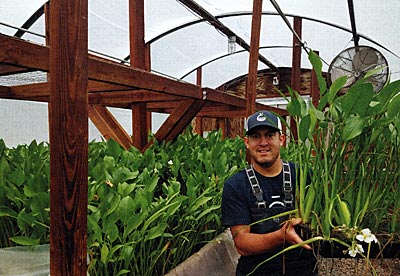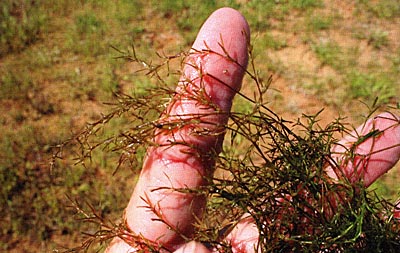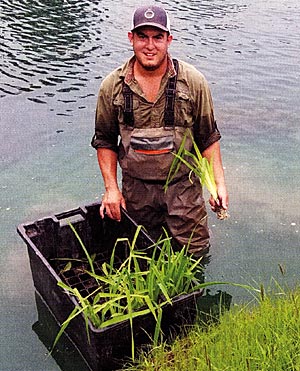
The peace and tranquility, teamed with excitement and curiosity, that lakes and ponds evoke is remarkable. Positively influencing those who are blessed to be around them, waterbodies are a focal point in the lives of many people. As much as we love our ponds, it can be distressing when undesirable aquatic vegetation is spreading throughout our beloved waterbody.
The term aquatic vegetation does not seem to sit well with many lake and pond owners. Most people who live around water have either had negative experiences or have heard horror stories about aquatic vegetation disrupting aesthetics and recreational uses. Because of this perception, aquatic vegetation and the benefits that it provides can be overshadowed by the fear and anxiety many people have toward plants that grow in water. Most waterbodies should have a zero tolerance for certain species of vegetation, especially exotic invasive species, but it is typically a mistake to view all vegetation as undesirable. If managed properly, healthy stands of native aquatic vegetation can be used to enhance your favorite pond or lake.
Actually, vegetation plays an important role in aquatic communities. Some of the positive attributes include: improving both water quality and clarity by utilizing available nutrients, discouraging toxic blue-green algae and other Harmful Algal Blooms (HABs), aesthetically pleasing flowers, erosion control, invertebrate production and refuge, periphyton production, and habitat and food sources for fish, waterfowl, amphibians, reptiles, and mammals.
The key to properly establishing and managing vegetation is to have a well-designed long-term strategy that is accepting of favorable plant species while implementing control measures to discourage undesired species. To do this, you will want a working knowledge of what characterizes a plant as bad or good in your particular application. A native plant that has positive attributes may actually be a terrible fit for your waterbody, depending on the management strategies that meet your goals and budget, while that same plant may be a perfect fit for your neighbor. A great place to start is to decide what the primary water uses are for the waterbody. Examples would be fishing, aesthetics, waterfowl hunting, swimming, drinking water, storm water compliance, etc.
Next, decide if herbicides or grass carp will be the primary method to control submersed vegetation. The use of herbicides will be more expensive than using grass carp, but using herbicides will allow you to selectively remove nuisance and invasive species while leaving the desirable natives unharmed. Grass carp do not provide this level of selectivity between natives and invasives, but, if stocked at the appropriate rate, they can serve as an economical option to control soft, pliable submersed vegetation, while allowing many emergent and floating species to remain.

When deciding whether herbicides or grass carp are the better fit, first gain an understanding of depth, volume, turnover rate (flow) and nutrient load. All four of these variables will contribute to the process of deciding which vegetation species are desirable, and which aren't, for the particular waterbody. Knowing your water depth provides insight into where a particular species of vegetation can establish, as well as what percentage of the waterbody it could occupy. Some plants cannot grow in water deeper than two feet, while others can grow in 10 or more feet. This variance in water depth could be the difference between plants covering two percent or 100 percent of your waterbody. Figuring out the water volume of your pond is helpful when projecting herbicide costs, as many in-water herbicide treatment rates are based on water volume.
How much flow a pond receives also affects herbicide application rates and strategies. Flow can also affect grass carp stocking strategies in states where they are legal, since grass carp are attracted to moving water and will leave if moving water allows them a path to escape. If the waterbody's nutrient levels are high (free phosphorus and total phosphorus, in particular), then it's important to be extra thoughtful when deciding on grass carp as your primary submersed vegetation control management tool. This is because ponds with high phosphorus are vulnerable to toxic blue-green algae blooms, and if grass carp eliminate all of the aquatic vegetation in the waterbody, then the toxic algae blooms will likely become more prevalent and difficult to manage.
Once you decide on goals, and have a general idea on how you plan to control undesired plant growth based on your pond's characteristics and budget, you can then finalize a list of the best plant species to promote for your situation. The process of choosing the best species for your situation is a skill that often takes fisheries biologists and aquatic ecologists years to develop due to the variables that need to be accounted for. Managing vegetation is an art form as much as it is a science. Ask your pro for help as you decide what to do.

Species commonly recommended in nearly all situations throughout the southeast include pickerelweed, duck potato, blue flag iris, and soft rush for the perimeter of a pond. Other species of vegetation that can be favorable under the right circumstances include water willow, spatterdock, water lilies, eelgrass, many species of Potamogeton, which are commonly referred to as the pondweed family, as well as both Chara and nitella, which are both species of macroalgae. Those are a mix of perimeter species and submersed types.
Typically, pickerelweed, duck potato, iris, sedges, rushes, and most other emergent species are a good fit for all waterbodies since these plants are inexpensive to control with herbicides and because they usually grow in water less than two feet deep. Their susceptibility to inexpensive herbicides gives people the peace of mind that if the plants start to impede on water uses, they can be controlled easily and inexpensively. Although these species of emergent vegetation aren't necessarily within the diet of grass carp, it is normal for low populations of grass carp to coexist with established stands of these plants.
Another two species of emergent vegetation that lend themselves as beneficial are water willow and spatterdock. Like the other emergent species, these grow in shallow water, but are sometimes considered less aesthetically pleasing. Despite that, these plants are a solid source of fish cover, especially for newly hatched babies. Water willow is great at preventing shoreline erosion.
Eelgrass, pondweed, water lilies, as well as macroalgae could be viewed as the next tier of favorable vegetation. Although they can be beneficial to the environment, they are known to venture in to deeper water, impeding the goals and uses of the water. As result, it is most efficient to utilize these species in systems with depths of more than eight feet, which naturally limits plant growth and adds a layer of complexity to the food web while enhancing the lives of all wildlife, especially fish and waterfowl. Deciding to tolerate these plants that grow in deeper water typically means that herbicides will be used annually to manage vegetation.
Once you have decided on your goals and the species of vegetation you want to encourage, make a plan to install the proper plants if nature doesn't provide them. The process of establishing desirable aquatic vegetation can be challenging. Vegetation can be a food source for many wildlife species such as crayfish, turtles, grass carp, geese, ducks, muskrats, nutria, beavers, and deer. Due to the wide variety of predators, efforts to establish beneficial vegetation can have a high rate of failure. Therefore, it is best to develop an incremental installation strategy to ease into the project and increase the odds of plant survival. Protecting newly planted vegetation with netting or cages is a common practice in waterbodies that will have high predation rates. When in doubt, work with a professional to increase your odds of success.
The process of deciding which plants to tolerate, as well as what management strategies you should implement, is a process that rewards those who put in the time to draw up a game plan. Although things will not always go to plan, it is helpful to have a strategy in place to monitor and control vegetation as necessary. Oftentimes, when vegetation becomes a significant problem, it is because a reactionary, rather than a proactive, management strategy was in place. Waterbodies are precious resources, and how they are managed will greatly influence their ability to positively affect those around them.
David Beasley is a Fisheries Biologist and the Director of Fisheries at SOLitude Lake Management, an environmental firm providing full service lake, pond, and fisheries management services throughout the United States.
Reprinted with permission from Pond Boss Magazine



